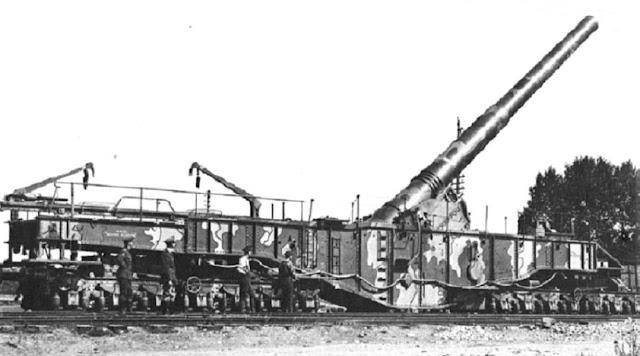
The 13.5 inch Gun was a combination of an obsolete mounting with an obsolescent gun as an emergency measure in 1940, when there was no long range heavy artillery available. The War Office appointed Lt Col Cleeve RA, one of the few remaining railgun experts to search for anything suitable that might be available. He knew there were some 14 inch railway mountings still available and he found some 13.5 inch guns in an Ordnance Depot near Nottingham. They had come from the Iron Duke class battleships and were close enough to the obsolete 14 inch guns to be fitted in the 14 inch mountings. It was decided to fit out three guns.
The first gun was delivered on the 20th September 1940 with the other two being completed by May 1941. The next problem was finding men to operate them. The army was unable to provide men but the Royal Marines, already operating two 14 inch guns near Dover, had men to spare so took over the three guns. The guns were all named using the same names they had in France in 1917-18. They were all sited in the area of Dover as follows:
HMG Scene Shifter at Lydden on the Dover/Canterbury line.
HMG Gladiator at Martin Mill on the Dover/Deal line.
HMG Piecemaker at Guston Tunnel on the Dover/Deal line.
The guns had two roles. Covering possible landing beaches in Kent and firing on the enemy positions in the area of Calais. This they could just reach firing Supercharge. The guns were not used very often as aiming required the gun to be pushed along a convenient curve in the track. Nor were they immune from attack theirselves. On the 10th December 1940 a 28 cm shell fell within feet of ‘Piecemaker’ damaging a bogie and killing a Marine. In November 1943 the guns were handed back to the army and withdrawn from the Dover area. They were formed into a Super Heavy Regiment RA and began training for the forthcoming invasion of Europe. In the event they were not required and the guns were declared obsolete in 1945.
The 13.5 inch Mark 5 Gun had entered service in 1912. It was a wire wound gun mounted on a simple box. The mounting was carried on two 4 axle bogies at the front and one 4 axle and one 3 axle bogies at the rear. A limited amount of traverse was provided by hauling the front end of the mounting across the bogie bolster. This was achieved by the use of warping winches at the trackside which were connected by cables to the mounting. The mounting did not move on firing.
Data
Gun Mark 5 on Railway Mounting 14 inch Mark 1
| Weight of gun & breech mechanism | 170,520 lbs |
| Total Length | 625.90 inches |
| Length of Bore | 607.50 inches (45 calibres) |
| Rifling | 68 grooves, uniform Right Hand 1/30 |
| Breech mechanism | Interrupted screw, electric or percussion fired |
| Elevation | 0º to +40º |
| Traverse | 2º right & left |
| Recoil system | Hydropneumatic, constant 34 inches |
| Weight in action | 539,224 lbs (240 tons) |
Performance
Firing standard 1,250 lb Shell
| Muzzle Velocity | 2,550 feet per second |
| Maximum Range | 40,000 yards |
Ammunition
Separate loading, bag charge
| Shell, HE, Mark 0 | Base fuzed Armour Piercing shell. Standard Naval pattern |
| Propelling Charge | Bagged 293 lbs of Cordite in 6 sections for ease of handling |
